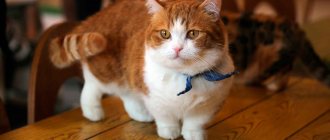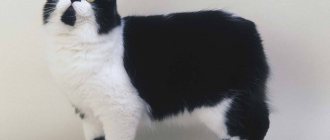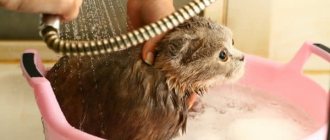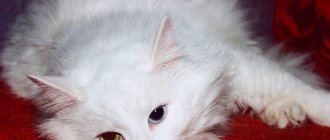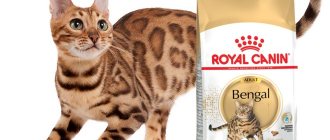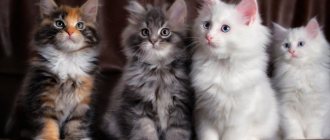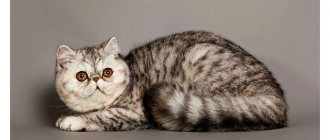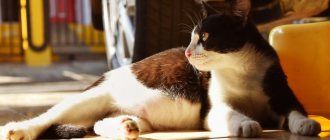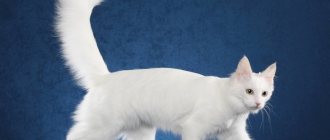Should I cut my cat's hair?
Furry pet lovers often wonder: is it possible to groom cats? The answer is clear - yes, it is possible, sometimes even necessary! Grooming cats and cats is becoming increasingly popular. The reasons are dictated by the need to provide complete care for your pet’s fur coat. And if you get creative, the animal takes on an interesting image.
Is it true that cats can be cut?
For cats that live in the private sector and spend a lot of time outdoors, careful care is essential. After a walk, your pet may return not only with dirty hair, but also with hair matted into lumps. In this case, scissors will come to your aid. And if your pet has long, thick hair, then to avoid such troubles it makes sense to get a beautiful haircut with the onset of the warm season. If your cat is domestic, and you have enough time, effort and patience to take care of your pet’s fur every day and keep it clean and tidy, you can avoid going to the “cat” hairdresser - groomer. Even if there is no need to cut your pet’s hair, it is advisable to use a fuminator or slicker; they comb out the dead undercoat without touching the living one.
Is it really possible to cut your pets' hair?
Cats that live in the private sector and are often outdoors require especially careful care. They walk in different places, including among various herbaceous plants. As you know, a large number of different parasites live in grass. To protect your pet from possible problems associated with them, you need to check its fur and skin every day. Of course, if the cat is completely domestic, and the owner has time to constantly care for its fur, then, in principle, there is no need for a haircut.
Many owners of purebred animals perform this procedure in order to ensure a well-groomed and tidy appearance for their pet. In addition, this greatly simplifies its care.
Why do you need a haircut?
Owners of furry pets have different opinions on this issue. Some are categorically against such a procedure, because they sincerely believe that the haircut disfigures the cat. And others not only take their pet to the hairdresser, but also maintain a regular schedule. There are several main reasons explaining why cats need a haircut: - Due to the increased body temperature of cats compared to humans, they can easily tolerate hot summer weather, but if the temperature outside exceeds 35-40 degrees, cats begin to feel unwell. If you decide to cut your pet’s hair to make its life easier, follow certain rules, or better yet, consult a specialist. He will calculate the required length of fur that needs to be left for the pet so that he does not become vulnerable to direct sunlight or catch a cold from a draft and air conditioning. — The appearance of bald patches on a pet’s body often frightens owners and leads to unplanned haircuts. But when the hair grows back, the bald patches remain. In this case, hairdressing services are not able to solve the problem, contact your veterinarian to find the cause and begin timely treatment. — During shedding, caring for a cat takes a lot of time and effort, and cleaning an apartment where fur constantly flies around is not fun. There is an opinion that if you cut an animal's hair, the problem will be resolved. This is a mistake - after growing overgrown, the cat will begin to shed again. If shedding time is delayed, contact your veterinarian. The specialist will find the reason, perhaps it is high humidity in the room, stress in the pet, or improper feeding. — Not all owners find a common language with their pet; cats simply do not allow themselves to be brushed. Thus, tangles form on the animal’s body, which tighten the skin, cause itching, and cause discomfort. A nest for fleas, fungi and various infections is formed under the mat. If your cat has thick, long hair, pay special attention to its care. — Another reason is the cohabitation of a cat and a person with upper respiratory tract diseases and allergies. Grooming cats will help allergy sufferers and asthmatics avoid a trigger (a factor that causes suffocation and exacerbation of the disease). — It happens that the pet is sick or too old. If an animal cannot properly care for its fur, a haircut will also help. - Pets need to be cut to be simply beautiful! This is especially true before exhibitions. A groomer will help you with a model haircut. It can be original, emphasizing the individuality of the pet.
To cut or not to cut your pet?
During a grooming, a cat gets stressed, which can lead to unpleasant consequences. However, the determining factor is the climate in which you live and where the pet spends most of its time - outdoors or indoors. When it's very hot outside and you want to help your four-legged friend, a haircut won't be a bad idea. Despite the obvious benefits (especially for long-haired cats), clipping has some disadvantages. A trimmed animal adapts less well to temperature changes. Cats walking outside can overheat in the sun, since their skin will not be protected by fur, and the pet can catch a cold. Therefore, you should not get carried away with this procedure. It is necessary to organize proper coat care, in this way you can avoid the formation of tangles and, as a result, the occurrence of skin diseases.
Varieties
Cat grooming can be classified into two types: hygienic and exhibition. The first type of care is aimed at ensuring and maintaining the cleanliness and health of the cat, giving the pet a well-groomed appearance. The care complex includes 7 different procedures:
- combing your pet's fur;
- swimming in warm water;
- wool cutting;
- cleaning ears;
- trimming long nails;
- eye wash;
- brushing your teeth
Exhibition grooming differs from regular grooming in that it is designed to bring a domestic cat to a certain standard established for a given breed. It is carried out by a professional groomer, paying more attention to the animal’s fur. This type of grooming is necessary mainly for cats that take part in exhibitions.
In this case, the master performs the haircut in such a way that the cat receives a minimum of unpleasant sensations.
Everything you need for a haircut
Of course, to cut a cat's hair, it is better to turn to specialists, but you can do a simple haircut yourself at home. The fur of different cat breeds varies in length, stiffness and density, and each pet will require a different approach. You will need:
- Table (you can use an ironing board);
- Scissors;
- Comb;
- Hair clipper (preferably with veterinary attachment No. 3);
- Hydrogen peroxide or iodine (in case of accidental injury to the pet's skin).
Before you start grooming your cat, be sure to trim its nails.
Manual typewriter
There is an alternative to electric clippers - a manual clipper. This tool resembles scissors or pruning shears and is operated by pressing the handles. A manual clipper is suitable for shy cats because it does not make any sounds. You can cut your pet's hair unnoticed by disguising the actions with caresses or even in a dream. The machine is easy to clean and cannot be broken. Another advantage of a manual typewriter is its low price.
But there are also disadvantages - the duration of a haircut increases significantly, and without certain skills, not everyone will be able to cut a cat’s hair neatly and evenly right away. A manual clipper is suitable for hygienic haircuts at home, but not for cutting before an exhibition or surgery.
How to properly cut a cat's hair
When cutting hair, it is advisable to find an assistant. He will hold the animal lying on its side, control the front legs with one hand and the hind legs with the other. It is necessary to fix the pet on the table surface quite firmly - the cat will escape out of fear, and the sound of the running machine will provoke it to escape. Try to use silent machines. It is necessary to cut cats according to a certain algorithm: start cutting from the sides, back and belly, move to the armpits, then the back. Then come the paws; if you wish, you can leave the “socks”. It is not necessary to cut the tail, but if you decide to tidy it up, leave a tassel at the end. If you decide to cut your cat's hair against the grain, use scissors and a special clipper, setting the cutting depth to 3 to 4 mm, which will prevent injury to the animal's skin. Do not forget to stretch the animal's skin in the area where the machine passes. Cutting against the grain is different in that a larger volume of hair is removed in one pass, but this method is mentally traumatic for the animal. After finishing the haircut, wipe the cat with wet wipes, or better yet, give it a bath to remove any remaining fur. Now all the fears are over, and she is ready to return to her normal life. This process is not simple, it has many nuances, and not all animals tolerate haircuts calmly. If you do not have enough skills to groom your pet on your own, it is better to contact a groomer: go to a special salon or call them to your home.
Recommendations for haircut and care
— The growing fur of a cat changes structure and color after cutting. — It’s not worth trimming the belly and back of cats with color point and tipping - the growing fur is several tones darker. — It is possible that the growing fur may not reach its original length. — It is strictly forbidden to trim the hair in the ears. Also, do not touch the hair on your head or whiskers with scissors! — It is recommended to trim especially active pets using sedatives. Do not do this yourself, contact a specialized salon.
Short-haired pets can be brushed once a week and bathed as you wish. Long-haired cats need to be washed at least once every 2 months and their coat thoroughly brushed daily. Experts recommend cutting the hair of cats with a length of more than 3 cm. It is better to consult with specialists about the possibility or necessity of cutting short-haired cats.
Grooming cats is a useful procedure that helps us and our pets. Cut your hair yourself or get help from a professional – it’s up to you. The most important thing is that your decision is thoughtful and brings benefit and comfort to our pets.
Source
Reasons why it is not advisable to cut your cat's hair
The opinions of veterinarians vary, but on some points they are unanimous:
The process of shearing is a strong shock and stress for the animal. As a result, a decrease in the body's immune defense may occur.- Due to frequent haircuts, the coat becomes thinner, which contributes to the formation of tangles more frequently.
- Constant haircuts can change the color, structure of the coat and undercoat. It becomes dull and brittle.
- The cat's skin becomes drier, often causes itching and leads to scratching, which will then have to be treated for a long time.
Veterinarians strongly do not recommend cutting cats with short-haired breeds or those with medium-length hair:
Who is doing?
Decor from animal fur can only be made by an experienced specialist in this matter.
Depending on the purpose of the haircut, it can be performed in different places. A veterinarian will trim the mats. The procedure is common in veterinary clinics, but it is also performed by a cat groomer in a salon. Complex types of artistic hairstyles and work with dense, long and thick fur, cutting Siberian, Norwegian and Persian cats is done only in zoo hairdressers. Decorative haircuts for cats should be performed by a groomer; it is better not to try to cut your pet’s hair artistically on your own - the cost of a mistake is too high.
When is a cat's haircut necessary?
There are situations when a four-legged friend really needs to cut his fur coat. Let's look at the main ones:
When a cat has a large number of mats of different sizes. Combing the animal in such cases may not always give results, since the tangles very quickly form dense wool balls, which are easier to cut out. In addition to being unsightly, tangles cause discomfort and health problems for your pet. By tightening the skin, they interfere with blood flow and cause itching. After all, by their nature, cats are very clean; they will try to get rid of the formed tangles on their own, scratching and gnawing out the lumps. But this is dangerous for the pet - he may accidentally swallow a hairball, which can block the passage in the digestive tract or cause severe vomiting.- Skin disease. It can be recognized by the appearance of weeping ulcers on the skin. The thick coat will make it difficult to treat with medications and will not provide adequate ventilation.
- Long molting. It can be caused by various reasons from skin problems to metabolic disorders. It is worth consulting a doctor in a timely manner.
- One of the family members has a wool allergy. But this method of getting rid of wool in the house is ineffective. After cutting, the amount of hair will decrease in volume, but if a person has an acute allergic reaction to wool, then the number of hairs on the pet’s body does not matter. We will have to look for other ways to combat allergies.
Types of haircuts for cats
A special hygienic haircut is carried out no more than twice a year, so as not to damage the structure of the coat and skin. If the cat must participate in an exhibition, the last haircut is done no later than six months before the event.
Trimming is usually done with a special clipper, leaving a hair length of approximately 3-3.5 millimeters. After this procedure, the animal’s skin becomes soft and velvety to the touch.
It is not advisable to cut your cat’s hair on your own, since a high-quality result will require many special tools:
- different types of hairdressing scissors,
- hair clipper,
- set of combs
It is forbidden to cut cats completely, that is, bald. This will disrupt the heat exchange process and can soon cause serious skin irritation.
Therefore, when grooming an animal, it is necessary to leave at least a minimum length of hair to protect it from sunburn or hypothermia.
Description and photo
Sometimes, for stylish reasons, show cats are given a model look by experimenting with types of trimming. There are many options for such haircuts now, but let’s look at the most popular ones:
- "Puma" - short hair on the body, and the head looks like a lion's mane;
- “Dragon” is a curly haircut in which hairs are left along the line of the spine, and various figures or symbols are cut from them;
- “Golfies” - hair is removed only on the upper part of the paws.
Required Tools
A hygienic grooming of a furry pet can be done using only scissors as the main tool. Naturally, they should have rounded ends, be well sharpened and not very large in size.
But it is preferable, of course, to use a trimmer (a special hair clipper). It is completely safe and you won’t be able to inadvertently injure your pet, and it does the job much faster and easier. The only problem that can become an obstacle is the noise the machine makes. Your pet may get scared of the device and simply run away. There are regular trimmers and ones for hard-to-reach places.
Additionally you will need:
- Comb with rounded teeth to avoid scratching the animal.
- Hydrogen peroxide and cotton wool in case you accidentally injure your pet.
- Bedding, for example, an old towel, which will have to be thrown away after the event.
- A table or couch is any horizontal surface where you can comfortably place your cat.
- A distracting object that the pet can engage in during the procedure, for example, a toy, a dental bone.
Which machine to choose for grooming a cat
Retail chains offer a very wide range of devices for grooming pets, from very expensive and functional to budget ones. The disadvantage of inexpensive models is, first of all, their unstable and indelicate operation - such models can cut fur poorly or pull out hair. Another disadvantage of budget models is that they overheat during use, and you can simply burn your pet. Inexpensive trimmers have a short service life.
As mentioned above, there are regular trimmers and ones for hard-to-reach places. The latest models are distinguished by their small size and shorter blades (no more than 2 cm). A similar device can be used to treat areas of anatomical curves, ears, muzzle, and areas under the tail. But this is more of an auxiliary tool; it is impossible to give a full haircut with it. Conventional trimmers are used for these purposes.
For representatives of especially fluffy breeds with a thick undercoat (Persians, exotics, etc.), choose devices with a power of at least 45 W, they will not overheat and can cope with thick hair.
Pay attention to the blades: they should be wide and sharp. The speed and delicacy of work depends on the sharpness of the blades
For cats with not very thick and long hair, you can use clippers with a power of 20 W or more.
A very useful option for the trimmer is the ability to automatically adjust the cutting surfaces
When choosing a device in a store, pay attention to this; not all models have this function. With a minimum length of cutting surfaces of 0.5 cm, the length of the pet's hair after cutting will be equal to 0.5 cm
It is dangerous to use devices with very small blades yourself at home - you can injure the skin of the animal.
Mains-powered electric trimmers are preferable to those that rely on batteries or a battery. They guarantee stable and long-term operation of the device. If you frequently have to pause and turn off the device while cutting, the battery or batteries may drain very quickly. An even more convenient option is models that have both a battery and a network connection.
The noise level produced by the device is also important. The quieter and more pleasant the device is, the more the cat will like it.
Make sure that the machine is comfortable to hold in your hands. It should be moderately light and moderately heavy.
It is difficult to ensure smooth movement with a device that is too light, and a device that is too heavy will quickly tire your hand. Therefore, try to find a “golden mean”.
Pay attention to the shape of the handle; it should fit comfortably in your hand and not slip out.
Be sure to check the device before purchasing, especially for overheating and foreign odors.
How to trim or shave a pet?
There is nothing complicated in grooming a cat if you follow the rules and sequence of actions:
- Nail trimming. The claws are trimmed with special tweezers, having been disinfected in advance. When you lightly press the paw pads, the hidden claws will extend. The owner will need to trim only the very ends.
- To begin with, you may need an assistant - he will hold the animal, preventing it from running away. Some cats react aggressively to the appearance of grooming tools. For the safety of the owner and the pet itself, it is worth putting a special plastic collar on the animal that does not allow it to bite.
The cat is laid on its side, its paws are fixed. To cut, you need a machine or scissors. The machine will help avoid damage to the skin, but can be frightening with its buzzing.- First, the hair is removed from the sides, and then moved to the back and belly. You need to remove hair as it grows, and in the opposite direction. Hair that remains long after cutting with a clipper can be trimmed with nail scissors. There must be a tassel on the tail.
- At the end of the procedure, the pet must be bathed with a special shampoo for cats, and then dried with a towel. If your pet is not afraid of a hair dryer, it can also be used for drying. But veterinarians still recommend going to a professional groomer. Because he is a competent and qualified specialist. He will do the haircut quickly and without any damage.
When performing a haircut of any shape, there are certain rules:
- in order not to damage the mustache and hair in the ears, the hair on the head, muzzle and in the auricle is not cut;
- “socks” are left on the lower part of the legs;
- the hairs of the front legs under the elbow and from the hind legs under the jumping joint are not removed;
- the hair is left at the end of the tail (a section at least 3 cm long must be left uncut).
Grooming at home
If you don't want to go to the salon, call a specialist at home. He will do everything quickly and at a reasonable price. If you take part in exhibitions with your pet, the cats are groomed by professionals.
Benefits of grooming at home:
- Familiar home environment. In addition, traveling to and from the salon is stressful for some cats.
- Convenience - you don’t need to go to the salon, choose a time and wait for your turn.
- Rapidity. A hairdresser will need much less time to groom a cat than the owner.
- Availability of necessary tools. Special scissors, brushes and clippers will allow the master to easily deal with long hair.
- Safety. The groomer will not damage the cat's delicate skin, as he has safe tools and knows how to trim correctly.
- No anesthesia. Anesthesia is contraindicated for cats: it will be difficult for the animal to recover from it, and for old pets it can be fatal.
- Prices are lower than in the salon.
Benefits and harms
Like any grooming procedure, cat trimming has its positive and negative properties. Let's look at them in detail.
Relief from heat and health problems. There is a very common stereotype that representatives of long-haired breeds suffer from heat, especially during the hot season.- It is necessary to cut a cat if for some reason (for example, due to age) it cannot care for its fur, and you do not have the opportunity to constantly care for it. All this can soon lead to a visit to the veterinarian, and in worst cases, to surgery.
- Caring for a cat can also save the lives of owners who suffer from allergies or asthma. It will help eliminate the factor leading to suffocation and exacerbation of the disease.
- Many cats have a negative attitude towards haircuts. It, like bathing, causes discomfort and stress for the cat. After this, the pet may be depressed, and due to resentment, it may even become offended and ignore the owner. Particularly proud pets can leave a “surprise” in their owner’s slippers in retaliation for an attack on their fur coat.
- After cutting, the cats' hairs become a little smaller. Even the color of the animal may become lighter. If the coat is shortened too much, the animal will feel unwell and may experience dryness and loss of elasticity.
- There are cases when in some areas of the skin the hair does not grow back after cutting. This means that alopecia appears. This is caused by hypothermia and improper hair growth. This condition is mainly characteristic of dogs, but there have been cases when it also occurred in cats. If baldness began to appear even before the cut, do not try to solve the problem: here you need to contact a veterinarian.
Situations in the wild when cats deliberately deprive their relatives of their whiskers
As it became clear, whiskers are an important sensory organ; naturally, whiskers are well aware of this, so in nature there are situations when cats deliberately pull out the whiskers of their relatives. First of all, we are talking about a fight, then rivals may try to deprive each other of their mustaches precisely because they are so important. Their loss automatically means the cat is weak and becomes more vulnerable. In disputes over territory in the wild, this situation is not uncommon.
Science also knows of cases where a mother cat chewed off the whiskers of her children. This was due to the fact that she did not want the babies to leave the makeshift “nest” prematurely. A kitten whose ability to navigate due to deformation of its whiskers was weakened more often remained near its mother, because It’s warm around her and, most importantly, safe. New vibrissae grew within six months. And all this time the kitten was forced to stay near the parent. Despite the fact that the mother cat had good intentions in such situations, such behavior still has more of a negative impact than a positive one.
It is forbidden to trim the whiskers of cats (or cats), this action is akin to depriving a person of one of his senses. Whiskers play an important role in a cat's life and their loss can lead to sad consequences, the severity of which varies from being in a bad mood to losing orientation in space.
